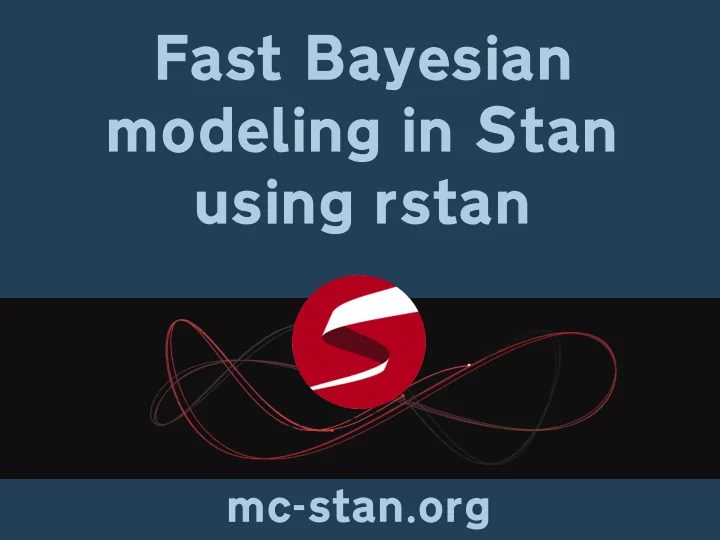

Fast Bayesian modeling in Stan using rstan mc-stan.org
Hamiltonian Monte Carlo Speed (rotation-invariance + convergence + mixing) Flexibility of priors Stability to initial values See Radford Neal ’ s chapter in the Handbook of MCMC
Hamiltonian Monte Carlo Tuning is tricky One solution is the No U-Turn Sampler (NUTS) Stan is a C++ library for NUTS (and variational inference, and L-BFGS)
http://www.stat.columbia.edu/ ~ gelman/research/published/nuts.pdf
rstan stan(file= ‘ model.stan ’ , data=list.of.data, chains=4, iter=10000, warmup=2000, init=list.of.initial.values, seed=1234)
Some simulations Collaboration with Furr, Carpenter, Rabe- Hesketh, Gelman arxiv.org/pdf/1601.03443v1.pdf rstan v StataStan v JAGS v Stata Today: rstan v rjags robertgrantstats.co.uk/rstan _ v _ jags.R
Rasch model (item-response) Hierarchical Rasch model (includes hyperpriors)
StataStan vs Stata vs rjags
rstan vs rjags Seconds: Rasch H-Rasch rstan 180 210 rjags 558 1270 ESS (sigma): Rasch H-Rasch rstan 22965 21572 rjags 7835 8098 ESS (theta1): Rasch H-Rasch rstan 32000 32000 rjags 19119 19637
rstan vs rjags
rstan vs rjags
Hierarchical Rasch model (includes hyperpriors)
data { int<lower=1> N; int<lower=1> I; int<lower=1> P; int<lower=1, upper=I> ii[N]; int<lower=1, upper=P> pp[N]; int<lower=0, upper=1> y[N]; } parameters { real<lower=0, upper=5> sigma; real<lower=0, upper=5> tau; real mu; vector[I] delta; vector[P] theta; } model { vector[N] eta; theta ~ normal(0, sigma); delta ~ normal(0, tau); mu ~ normal(0, 5); for(n in 1:N) { eta[n] <- mu + theta[pp[n]] + delta[ii[n]]; } y ~ bernoulli_logit(eta); }
data { int<lower=1> N; int<lower=1> I; int<lower=1> P; int<lower=1, upper=I> ii[N]; int<lower=1, upper=P> pp[N]; int<lower=0, upper=1> y[N]; } parameters { real<lower=0, upper=5> sigma; real<lower=0, upper=5> tau; real mu; vector[I] delta; vector[P] theta; } model { vector[N] eta; theta ~ normal(0, sigma); delta ~ normal(0, tau); mu ~ normal(0, 5); for(n in 1:N) { eta[n] <- mu + theta[pp[n]] + delta[ii[n]]; } y ~ bernoulli_logit(eta); }
data { int<lower=1> N; int<lower=1> I; int<lower=1> P; int<lower=1, upper=I> ii[N]; int<lower=1, upper=P> pp[N]; int<lower=0, upper=1> y[N]; } parameters { real<lower=0, upper=5> sigma; real<lower=0, upper=5> tau; real mu; vector[I] delta; vector[P] theta; } model { vector[N] eta; theta ~ normal(0, sigma); delta ~ normal(0, tau); mu ~ normal(0, 5); for(n in 1:N) { eta[n] <- mu + theta[pp[n]] + delta[ii[n]]; } y ~ bernoulli_logit(eta); }
And... Missing data CAN be included (coarse data too) as latent variables mapped to observed values Discrete parameters CAN be approximated with steep(ish) logistic curves
Getting started mc-stan.org stan-users Google Group
Recommend
More recommend